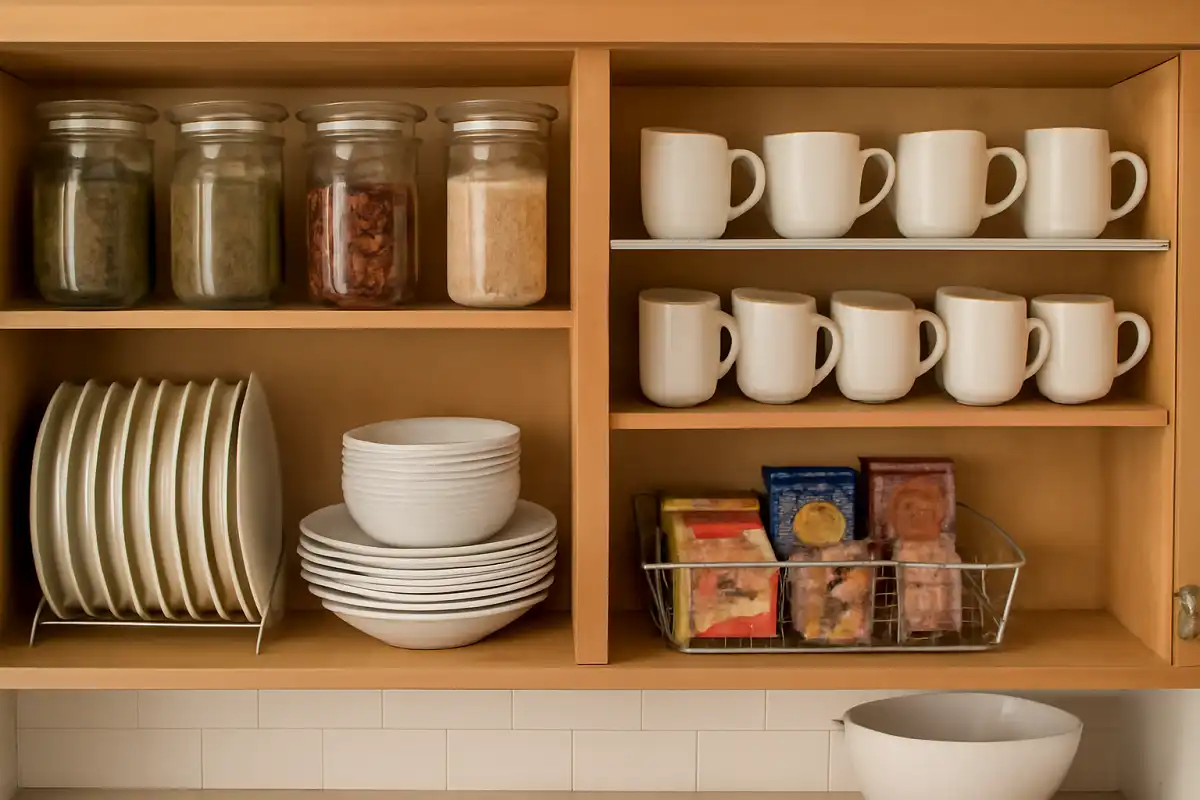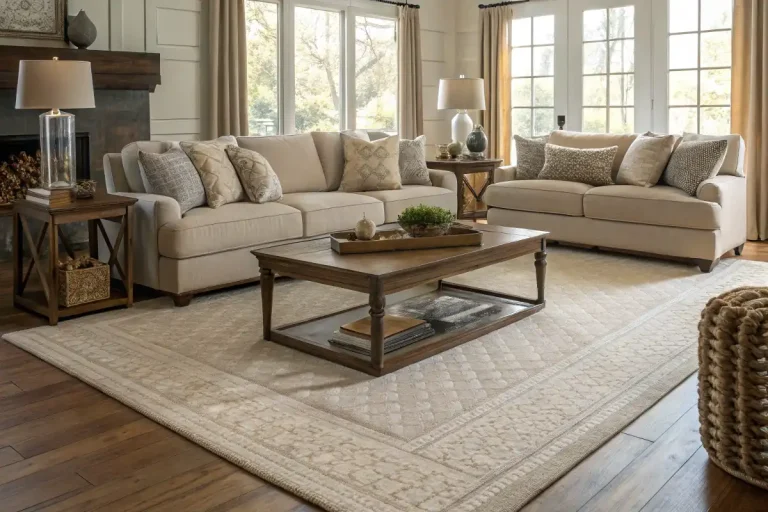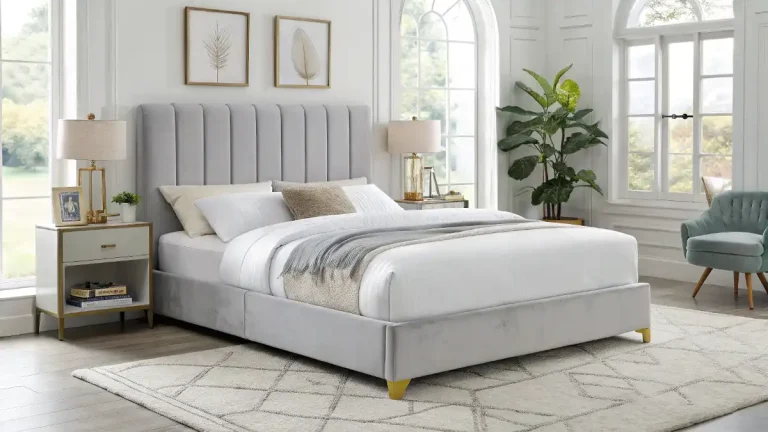How to Organize Kitchen Cabinets? Kitchen Cabinets Design
A tidy, well-organized kitchen is more than just pleasing to the eye – it actually makes daily cooking and cleaning much more efficient and less stressful. For example, experts note that “proper kitchen organization can significantly reduce cooking times and increase efficiency”. In practice, this can translate to spending up to 40 hours a year less time searching for items and preparing meals. Modern homeowners care not only about style but also about sustainability and health. The latest trends (including the NKBA’s 2025 Kitchen Trends Report) emphasize clutter-free, multifunctional kitchens that connect to nature and support healthy living. In this comprehensive guide, we’ll combine professional strategies and the newest research to show you how to organize kitchen cabinets so your kitchen works as hard as you do – saving time, reducing waste, and improving your day-to-day life.
Table of Contents
Step 1: Decluttering and Assessment – The Foundation of Lasting Organization
Before adding any fancy storage solutions, start by emptying your cabinets and sorting through everything. This decluttering step is crucial: remove expired foods, damaged dishes, mismatched lids, and duplicates. One proven method is to apply the KonMari philosophy: hold each item and ask if it “sparks joy” or serves a purpose. If an item no longer fits your cooking habits or lifestyle (and especially if it’s expired), let it go. For example, Marie Kondo’s team advises discarding truly expired foods or things you haven’t used – since they’ll never serve you well in the kitchen.
- Discard expired or unusable items: Toss out old spices, stale pantry goods, and chipped dishes. This immediately frees up space.
- Apply the KonMari joy-check: If a utensil, gadget, or container no longer “sparks joy” in your daily routine, donate or discard it.
- Use the 80/20 rule: Recognize that you probably use ~20% of your tools 80% of the time. Set aside rarely used items (holiday bakeware, serving platters you never reach for) for special storage or donation.
- Create an inventory: Make a simple list or spreadsheet of what you own, including food, small appliances, and tools. This digital inventory helps identify duplicates or underutilized items, guiding what to keep.
Once you’ve pared down, measure every cabinet carefully (width, depth, height). Note any awkward spaces or deep corners. This assessment ensures that when you buy organizers or custom inserts, they actually fit your kitchen’s dimensions.
Step 2: Strategic Categorization and Zoning – Creating Your Kitchen’s Organizational Blueprint
After decluttering, group and store items based on how you actually use them, not just by type. Today’s designers recommend a zone-based approach to the kitchen layout. Instead of trying to memorize categories, think in terms of “work zones” or stations that align with your cooking workflow:
- Pantry/Food Storage Zone: All non-perishables, spices, oils, and frequently used dry goods. Keep these close to the refrigerator and counter prep areas. According to kitchen design experts, “pantry storage” zones should hold fresh and canned foods alongside dinnerware or utensils needed for quick access. In this zone, use first-in, first-out (FIFO) rotation: label dates and place newer items behind older ones so you use up old stock first and reduce waste.
- Preparation Zone: Store cutting boards, knives, mixing bowls, and commonly used gadgets (blender, mixer) near your main prep counter. For example, deep drawers with utensil dividers or roll-out trays keep knives and tools at hand.
- Cooking/Baking Zone: Arrange pots, pans, and baking sheets near the stove or oven. Spices and oils also belong here, on pull-out shelves or lazy Susans just beside the cooktop for quick seasoning access.
- Cleaning/Utility Zone: Keep dishware, glassware, and dishwasher supplies near the sink. Under-sink space should house trash/recycling bins and cleaning products. Hooks on the inside of doors can hold dishcloths or small utensils.
By working with these activity zones, you minimize movement and confusion. The classic “work triangle” (sink-stove-fridge) still applies, but modern kitchens often use multiple smaller triangles or zones to accommodate more chefs and tasks. Customize your zones for your family: perhaps a dedicated coffee and breakfast station by the toaster, or a baking center with mixing tools and baking ingredients in one cabinet. Store daily-use items at eye or waist level for easy reach, and seasonal or rarely used items in high or low cabinets. In short: place what you use most where you use it most. (backsplash design ideas)
- Activity-based grouping: Rather than “all baking stuff here,” group by task. For example, create a coffee/tea station (mugs, kettle, coffee) and a meal-prep station (cutting boards, knives, bowls) in the most convenient cabinets.
- FIFO pantry storage: Label food and rotate older items to the front so they’re used first, cutting waste and keeping your supply fresh.
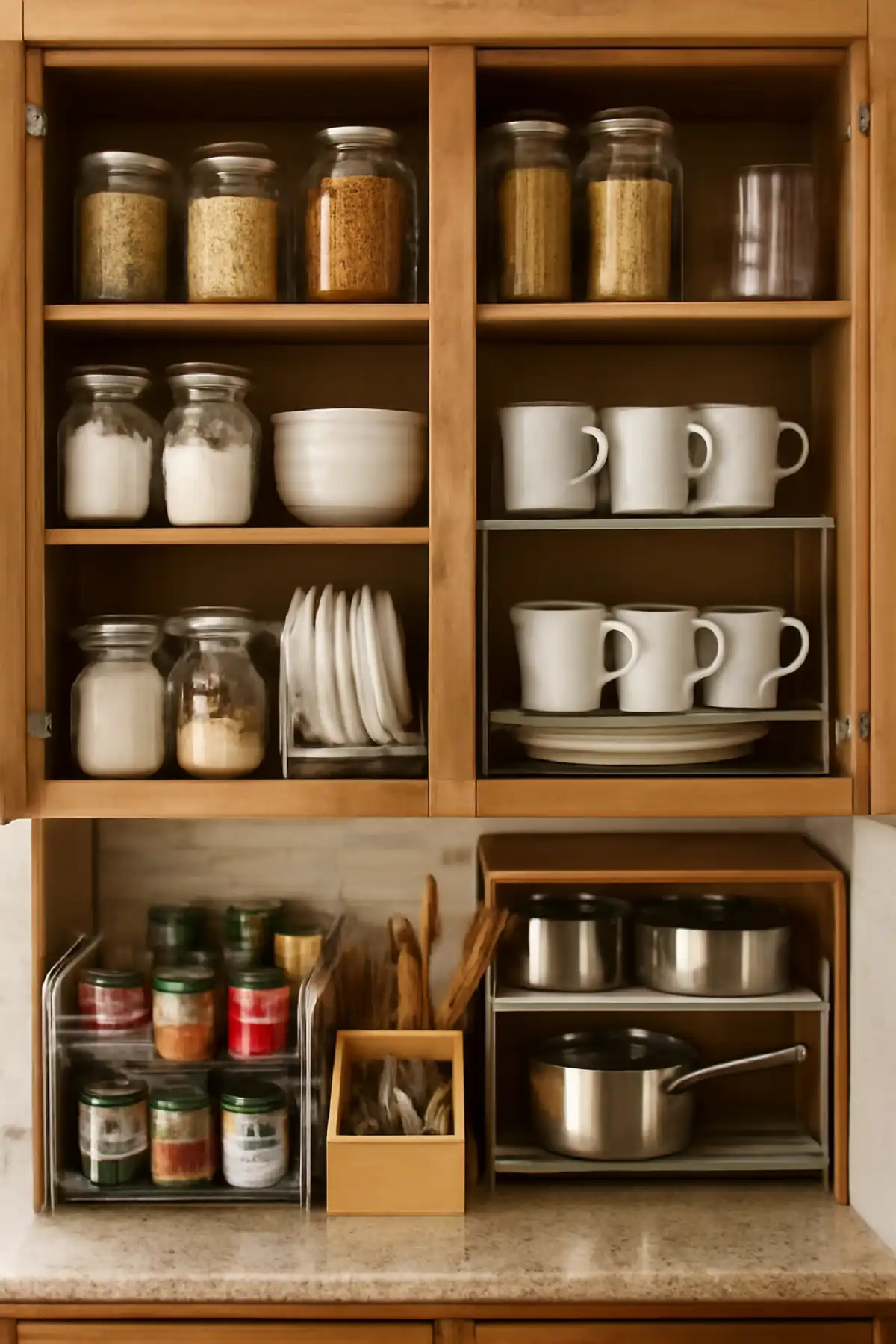
Step 3: Storage Solutions for Different Cabinet Types – Tailored Systems for Maximum Efficiency
With a decluttered, zoned kitchen, add storage tools that fit each cabinet type:
- Upper Cabinets: Maximize vertical space. Use stackable shelf risers to store plates or cups at two heights, effectively doubling capacity. Consider a pull-down shelf mechanism (available from many cabinet makers) so deep upper shelves are still reachable. Glass-front doors on upper cabinets can encourage neat, symmetric arrangements – they invite you to keep things orderly. Also, remove bulky packaging: transfer grains, pasta, and snacks into clear, uniform containers. (This “unboxing” of pantry staples not only looks nice but makes it easy to see at a glance what you have.)
- Lower Cabinets: These handle heavy, bulky items. Pull-out shelves or drawers are a must here – especially for pots, pans, and appliances. For example, a pull-out shelf lets you slide your mixer out like a drawer. Soft-close hinges and drawer slides prevent slamming and prolong hardware life. Use vertical dividers inside a lower cabinet to store cutting boards or cookie sheets upright, saving space and keeping them accessible.
- Pantry Cabinets: Outfit pantries with adjustable shelving. Uniform glass or BPA-free plastic containers (labeled with contents) keep dry goods tidy and visible, and many brands now offer nesting sets in bamboo or recycled materials. Open wire drawers or sliding shelves make it easy to pull out far-back items. (In 2025, designers even recommend hidden pantries: 87% of industry pros say homeowners want pantries concealed behind cabinet panels for a sleek look.)
- Corner Cabinets: These often contain “dead” space. Solve it with a Lazy Susan or pull-out carousel shelf. Newer corner units can have multi-tier rotating shelves that swing out or spin, giving you access to every inch.
Modern kitchen organization has become very detailed – it’s no longer an afterthought in design. Cabinet makers now offer deep peg drawers for dishes, pull-out utensil racks, spice pull-outs, and even “drawer-in-drawer” systems to subdivide one large drawer into smaller compartments. Plan your cabinet interiors as carefully as their exteriors: it’s these interior organizers that make your space truly functional.
More echo home ideas: Green Home Organization
Step 4: Specialized Organization Techniques – Proven Professional Methods
Beyond the basics, professional organizers recommend clever tricks for often-wasted spaces:
- Door-Storage Add-ons: Attach slim racks or magazine holders inside cabinet doors to store pot lids or cutting boards vertically. Magnetic strips on the backs of doors can hold spice jars or metal utensils. Adhesive hooks are perfect for hanging oven mitts, measuring spoons, or small utensils inside a door. This turns wasted interior door space into valuable storage.
- Drawer Dividers and Inserts: In deep drawers, use bamboo or plastic cutlery trays with adjustable dividers. The Container Store and others sell customizable inserts that can be cut to fit any drawer. These keep forks, spatulas, and tongs each in their own spots. (Just recently, home organization experts noted a “drawer organization revolution”, with homeowners favoring modular, moveable dividers customized to their needs.) Also consider stackable or expandable utensil trays: you can add or remove sections as your collection grows.
- Vertical Stacking: Whenever possible, store items vertically. Nest pots and pans by size, and stack plates or bowls into tidy towers. Use plate dividers in cabinets so dishes don’t chip when stacked. Place a vertical wine rack or knife block in a cabinet corner to free up drawer space. Under-shelf wire baskets (hung from an existing shelf) can create an extra mini-shelf for small items like spices or packets.
- Specialty Zones: Allocate specific spots for emerging kitchen hobbies or eco-habits. For example, if you brew pour-over coffee or use single-serve pods, carve out a “coffee bar” zone with beans, filters, and mugs all stored together. Similarly, set up a “zero-waste” station: keep a designated cabinet for reusable bags, glass containers for food scraps (compost), and eco-friendly cleaning supplies. This makes sustainable habits second nature – you won’t have to scramble for a compost bag or reusable produce bag at the last minute.
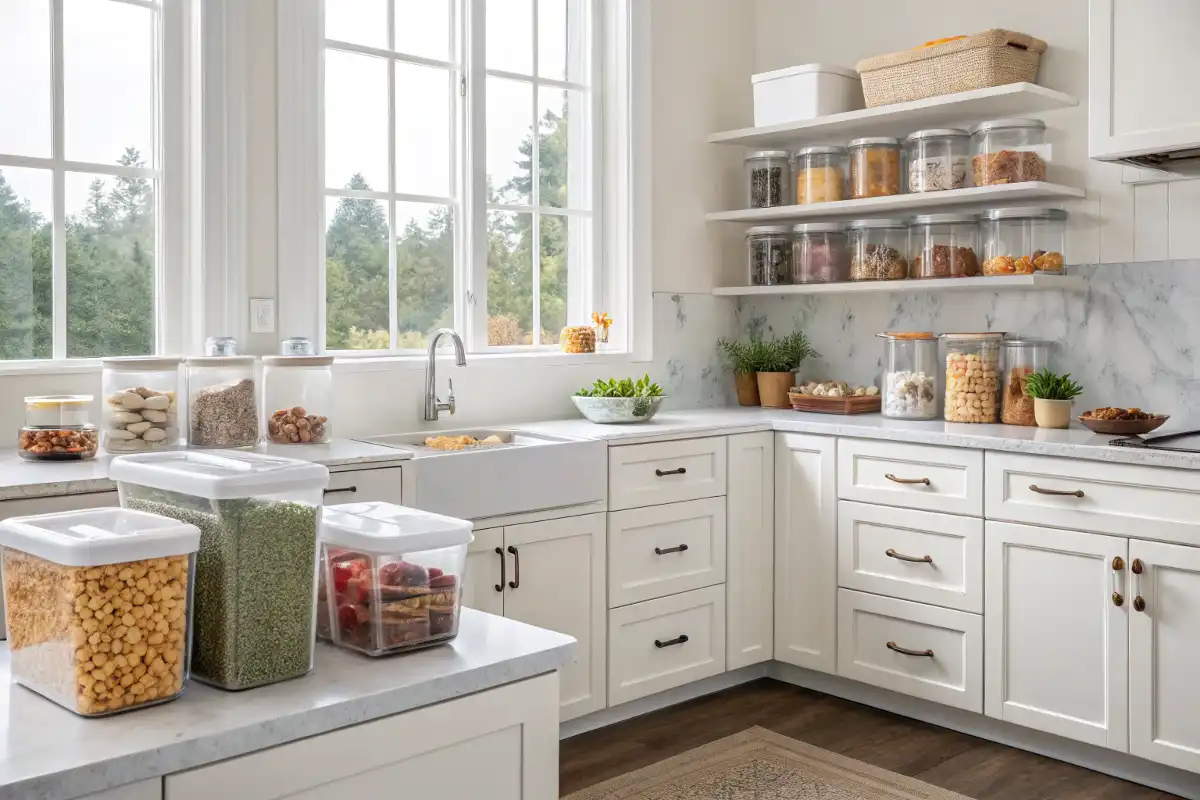
Step 5: Recommended Organizers and Tools – 2025’s Top Solutions
Invest in quality organizers where it counts, and get creative on a budget where you can:
- Premium Organizers: Choose sustainable materials. Bamboo drawer dividers and racks are durable, renewable, and fit the natural aesthetic popular in 2025. Stainless steel or recycled-metal racks (with powder-coated finishes) offer longevity. Look for slim-profile, expandable shelves that can be adjusted to your cabinet’s width. High-end pull-out systems (for spices, trays, or cleaning supplies) can be had with soft-close features and full extension glides. These are no longer luxury items but standard recommendations in modern kitchen planning.
- Smart Storage Technology: The digital age has arrived in kitchen cabinets. “Smart” storage tools can track your inventory and even talk to your devices. For example, there are containers with built-in weight sensors that automatically log how much remains and can signal your app or digital list when supplies run low. Cheaper QR-code labels offer a simpler approach: you stick a QR label on a jar and scan it with your pantry app to update counts or expiration dates. Beyond containers, consider voice-activated lighting and displays: motion-sensor LED strips under shelves light up dark corners, and smart bulbs can be turned on by voice command when your hands are full. Some ambitious homes even use pantry management apps: users report these can cut food waste by up to 70% by alerting you to expiring items.
- Budget-Friendly Hacks: You don’t always need special products to get organized. Repurpose household items: for instance, a metal shoe rack at the bottom of a cabinet can neatly hold spices or jars; dollar-store bins can separate snacks in a cupboard. The key is to keep a uniform look if possible (clear or matching bins) so it feels intentional. Even simple ideas help: a tension rod under a sink can hang spray bottles, and magazine holders on countertops can corral cutting boards or pans. Always try to use eco-friendly materials when possible – after all, organizing is not just about looking good, but about responsible living.
- Custom Solutions: For the ultimate fit, custom cabinetry inserts are unmatched. If you have an unusual cabinet shape or extra-deep drawers, a carpenter can craft exactly-sized organizers. In fact, industry surveys find that many homeowners now expect custom-fit organizers as part of their kitchen remodel. Custom built-ins eliminate all dead space. For example, a cabinet with a built-in peg drawer for plates or a pull-out spice rack can make everything accessible without wasted gaps.
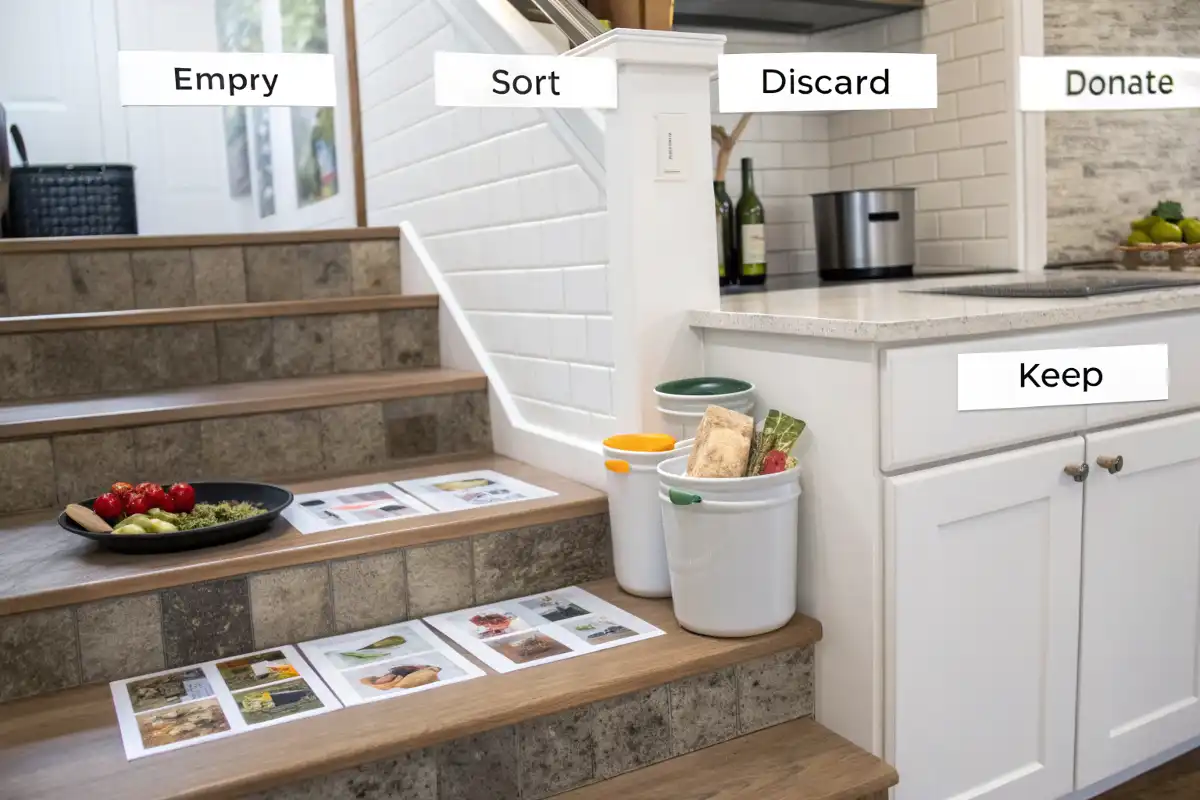
Step 6: Maintenance Strategies – Ensuring Long-Term Success
Building a great system is only half the battle – you must maintain it. Implement simple routines so the organization sticks:
- Quarterly Reset: Every few months, pick one cabinet or zone and empty it out completely. Wipe down the shelves and reassess what’s actually being used. Remove any products that have expired or that you haven’t needed since your last reset. Michigan State University experts advise taking inventory and discarding stale food during these resets. Refill only the items you really use and reorganize the cabinet with any new insights.
- The One-In, One-Out Rule: Make it a habit that whenever you bring a new item into the kitchen (say, a new Tupperware or gadget), you remove an old one. Professional organizers recommend this rule to prevent gradual clutter creep. As one home decor writer found, committing to “one-in, one-out” meant donating or tossing items before accepting new ones – freeing up space and keeping drawers from overflowing.
- Daily Micro-Habits: Little habits each day keep clutter at bay. For example, spend 5 minutes each evening returning stray items to their homes – a quick scan of countertops and counters after dinner. Professional organizers note that minimalists often clear their kitchen every morning: putting away breakfast dishes and wiping counters before heading out. These tiny resets mean you always start with a clean slate, rather than dealing with a huge mess later.
- Seasonal Adaptation: Your kitchen’s needs may change with seasons or life events. In summer, you might use more grilling or canning supplies; in winter, perhaps more baking tools. Be ready to shuffle things – for instance, store barbecue marinades and grilling tools together in spring, then swap them out for holiday bakeware when autumn arrives. Having a flexible system (with adjustable shelves and movable bins) makes these transitions easy.
Evolution of Kitchen Organization: Traditional vs. Modern Approaches
| Aspect | Traditional | Modern (2025) |
| Philosophy | Hide all clutter behind closed doors. | Embrace intentional design and visible order. |
| Space Utilization | Simple shelves, under-used vertical space. | Multi-tiered pull-outs, lazy Susans, under-shelf racks to use every inch. |
| Categorization | Group only by item type (plates, glasses). | Activity-based zones (coffee station, baking center). |
| Storage Solutions | Fixed shelves, basic drawer dividers. | Customizable, modular organizers and specialized cabinets. |
| Sustainability | Little focus on eco-materials. | Emphasis on recycled, upcycled, and natural materials throughout. |
| Technology | None. | Smart solutions: inventory apps, voice-activated lighting, sensor-based containers. |
| Aesthetics | Matching opaque containers. | Clear or natural material containers; curated displays; pops of color and wood tones. |
| Maintenance | Major cleanups only when messy. | Small daily habits and periodic check-ins for lasting order. |
| Flexibility | Rigid layouts, hard to reconfigure. | Adjustable systems, redesignable zones, adaptable for changing needs (e.g. work-from-home, new hobbies). |
| Pantry Storage | Items left in original packaging. | Items decanted into matching jars with clear labels for visibility and freshness. |
| Clutter Prevention | Reactive: just clean up a mess when it happens. | Proactive: systems and habits to prevent clutter buildup (e.g. one-in/one-out rule, FIFO rotation). |
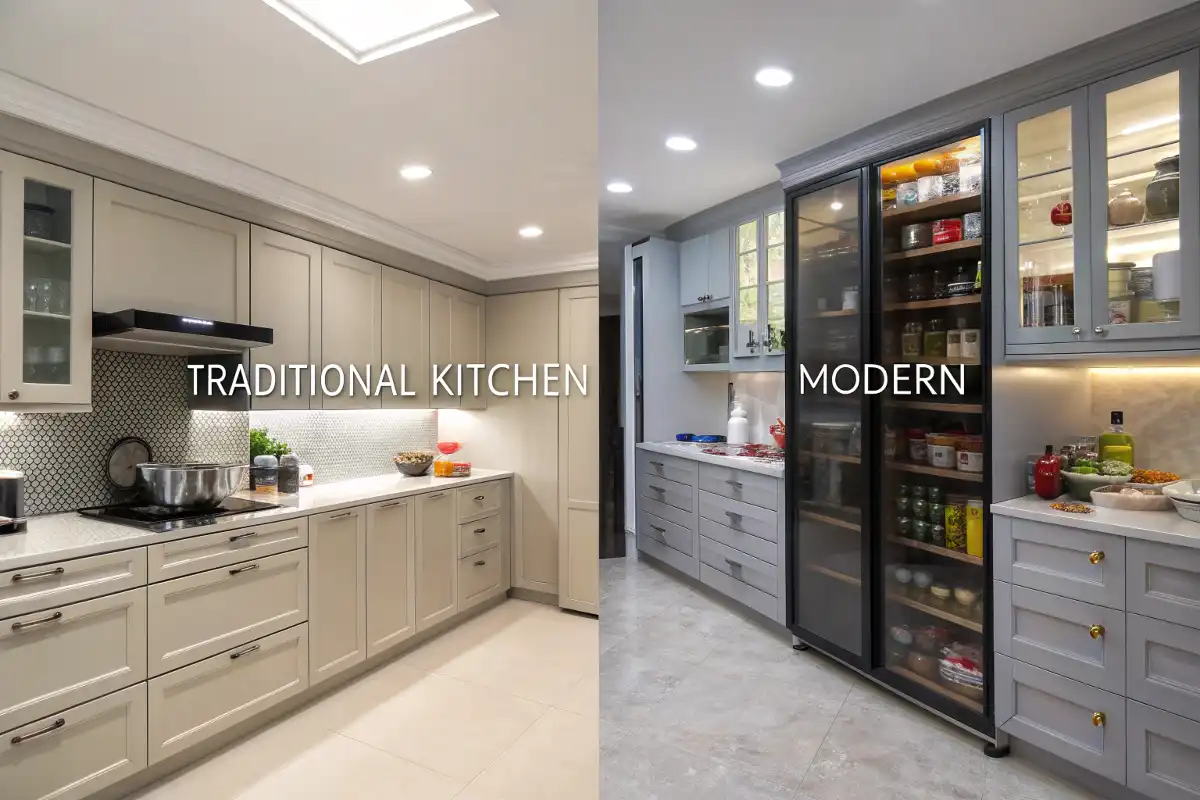
2025: The Future of Kitchen Cabinet Organization – Emerging Trends
Looking ahead, kitchen organization is going even further to blend beauty, wellness, and technology:
- Biophilic Design: Bringing nature into the kitchen is huge. The NKBA reports that 72% of designers say homeowners want a stronger connection to the outdoors in their kitchens. This shows up as wooden organizers, bamboo drawer inserts, cork shelves, and even indoor herb gardens built into cabinetry. Imagine a pull-out spice rack that actually grows fresh herbs, or stone and bamboo container sets that feel natural. Large windows, living plant boxes, and natural light are all becoming design elements of organization. In short, 2025 kitchens often look like a warm eco-friendly pantry, not a sterile utility room. (kitchen window organization)
- Sustainable Materials Revolution: Eco-friendly solutions have gone mainstream. Kitchens now use recycled glass jars for dry goods, bamboo or mango wood bins for produce, and even upcycled metal racks. The ASD trend report notes “bamboo utensils, recycled glass storage containers… turning kitchens into showcases of environmental responsibility”. Designers say over 80% of pros see growing demand for recycled/upcycled products, and most remodel projects include recycled materials. Compostable bins for scraps and reusable drawer liners are also on trend. Every choice – from the drawer organizer to the cabinet knobs – is influenced by sustainability.
- Personalized Systems: One-size-fits-all is out. Organization is now highly customized to each family’s routines and values. Whether you’re gluten-free, love meal prepping, or have kids who help cook, your kitchen layout can reflect that. Designers emphasize that the kitchen is a home’s personality hub: 92% say it should reflect the homeowner’s lifestyle. For example, a vegan chef might dedicate a shelf to spices and grains, whereas a family of coffee lovers might install a built-in coffee grinder and mug rack in the cabinet. Even color and finish choices factor in: many people now choose bamboo (for warmth) or bright colors (for personality) in their organizers.
- Smart Technology Integration: The “smart kitchen” extends to storage. As mentioned, smart containers and apps are key. Inventory management gadgets can alert you when items expire or run low, preventing overbuying. Voice-activated setups are emerging: imagine saying, “Show me my spices”, and a built-in cabinet light focuses on your spice rack, or a smart display shows what’s inside the fridge and pantry. Weight-sensing shelves are not far off – some companies are developing pantry shelves that notify you via your phone when flour or sugar is low. All this tech makes kitchen organization proactive rather than passive.
- Multifunctional Spaces: Kitchens are now offices, classrooms, and dining rooms. Organization reflects that: hidden nooks for a laptop station, drawers for craft or homework supplies, and pull-out tables are part of the plan. The 2025 trend report found 90% of homeowners want kitchens that improve functionality for home life. Examples include a kitchen island that converts from prep area to dining table, or coffee countertop accessories built into a drawer (for espresso cups and tablets). Specialty zones for hobbies – like a wine bar cabinet or a baking pantry – are also popping up. Every inch is being imagined for multiple uses.
In other words, the future kitchen is not just a place to cook, but a sustainable, personalized hub equipped with high-tech assistance. The movement to “unbox” pantry staples (decanting into uniform containers) continues to grow because it’s both beautiful and practical – you see what you have at a glance, reducing waste and clutter.
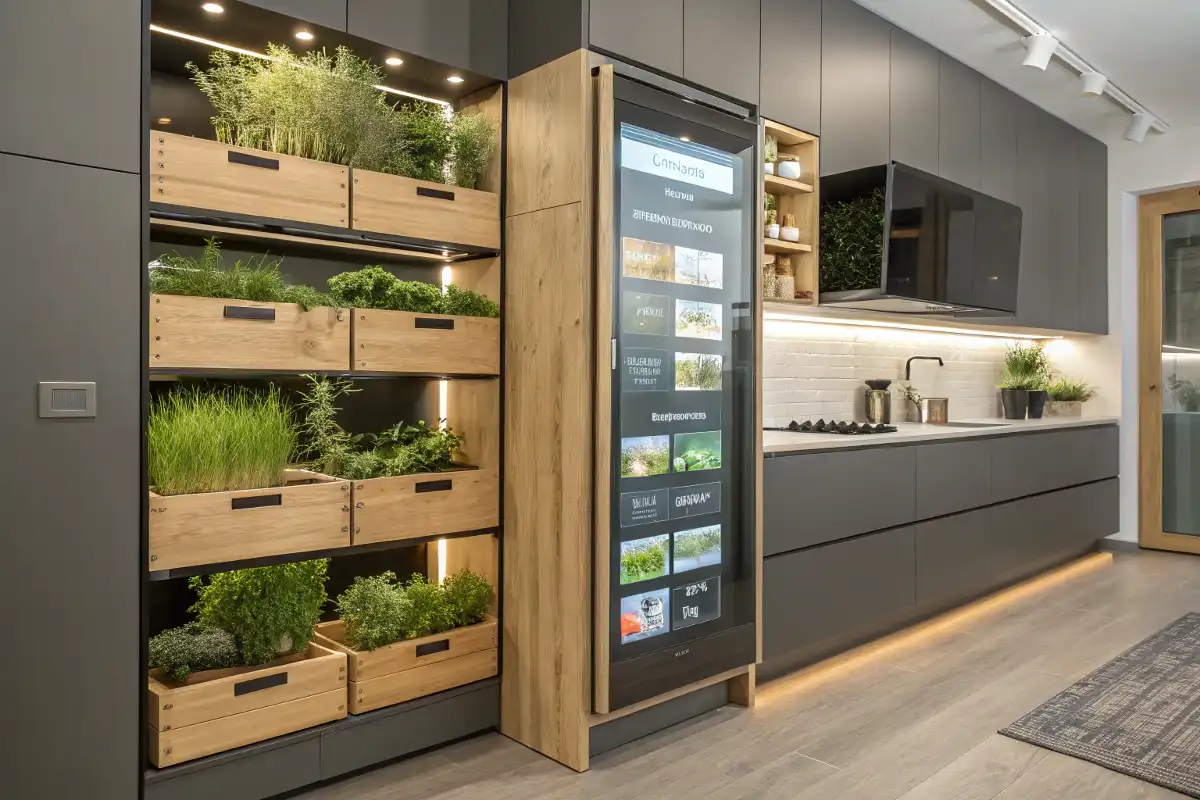
Frequently Asked Questions (FAQ)
Q: What is the first step to organize kitchen cabinets?
A: The first step is decluttering. Empty all cabinets, remove expired food, damaged items, duplicates, and things you no longer use. Apply the KonMari method by asking if each item “sparks joy” or serves a purpose. Then, create an inventory of what you keep.
Q: How should I categorize items in my kitchen cabinets?
A: Group items by activity zones instead of just type. Create zones like Pantry/Food Storage, Preparation, Cooking/Baking, and Cleaning. Store items where you use them most — for example, keep spices near the stove and mugs near the coffee maker.
Q: What are the best organizers for deep corner cabinets?
A: The best solutions for corner cabinets are lazy Susans or pull-out carousel shelves. These rotating systems make it easy to access items in the back and eliminate wasted “dead space.”
Q: How can I reduce food waste through kitchen organization?
A: Use the FIFO (First-In, First-Out) method: place newer groceries behind older ones so you use up older items first. Label containers with purchase dates and consider smart storage with inventory apps that alert you to expiring items.
Q: Should I use clear or opaque containers for pantry storage?
A: Clear, airtight containers are best for pantry storage. They let you see contents at a glance, keep food fresh, and create a uniform look. Use labeled containers made from glass, BPA-free plastic, or sustainable materials like bamboo.
Q: What are the latest trends in kitchen cabinet organization for 2025?
A: Top 2025 trends include biophilic design (wood, plants, natural light), sustainable materials (bamboo, recycled glass), smart technology (inventory-tracking containers, voice-activated lights), and custom, multifunctional zones tailored to your lifestyle.
Q: How often should I reorganize my kitchen cabinets?
A: Do a quarterly reset of one cabinet or zone — empty, clean, and reassess what you use. Also, practice daily micro-habits like a 5-minute tidy-up after dinner to maintain order and prevent clutter buildup.
Q: What is the one-in, one-out rule for kitchen organization?
A: The one-in, one-out rule means that for every new item you bring into the kitchen, you remove one old item. This prevents clutter and helps maintain a balanced, functional space over time.
Q: Can I organize my kitchen on a budget?
A: Yes! Use budget-friendly hacks like repurposing a metal shoe rack for spices, using magazine holders for cutting boards, or installing tension rods under the sink to hang bottles. Focus on uniformity (e.g., matching bins) for a clean, intentional look.
Q: How do I organize a small kitchen efficiently?
A: Maximize vertical space with shelf risers, use door-mounted racks, install pull-out drawers, and use stackable containers. Focus on zoning and multi-functional furniture (like a kitchen island with storage) to make the most of limited space.
Small Space Ideas: Small Space Storage Ideas
Conclusion: Building Your Perfectly Organized Kitchen
A well-organized kitchen cabinet system saves time, reduces stress, and even promotes healthier habits by making cooking easier. The key principles are simple: start with decluttering, group items by how you use them, choose the right organizers for each space, and maintain your system with smart habits. Take it step by step – perhaps begin with one cabinet or drawer – and gradually transform your whole kitchen. Remember, the goal isn’t perfection overnight but creating a sustainable system that works with your daily routine. As experts remind us, a little bit of organization each day (or a quarterly refresh) goes a long way.
By applying the methods above – from category-based zoning to high-tech storage solutions – you’ll end up with a kitchen that reflects the 2025 ethos: efficient and elegant, personal and practical. Whether you’re a busy parent, a health-conscious cook, or someone who just hates hunting for the right lid, these professional tips will turn your cabinets into an asset. In the long run, an organized kitchen pays dividends in saved time, reduced food waste, and less daily hassle. After all, a cabinet system that’s thoughtfully designed (with sustainable materials and smart ideas) is not just storage – it’s part of a healthier, happier home.
